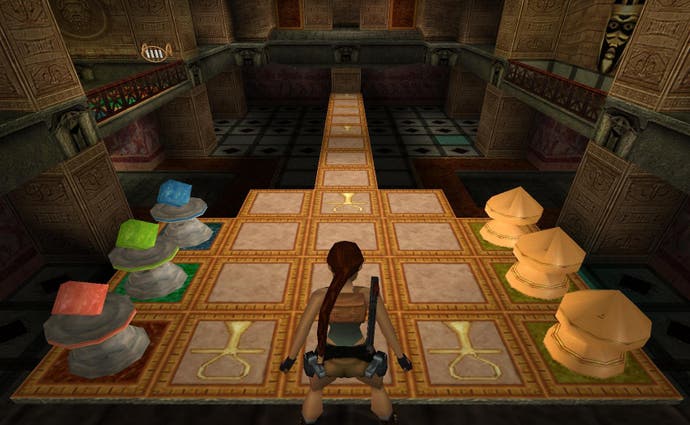Retrospective: Tomb Raider: The Last Revelation
Death becomes her.
Because Tomb Raider assumes it's being played on a gamepad, the nature of jumping, rolling, crouching and firing is designed around a collection of buttons. But since Lara can't make a slight turn without launching herself onto the nearest spikes, the ambiguity of both an analogue stick or d-pad is useless. So it's left hand on the keyboard to steer, right hand on the right half of the gamepad.
And it works. Suddenly the game is under my control. Or as much control as the games offered. For Lara cannot run to her left or right - something we're so used to in games now that its absence feels like a missing limb. She's steered from behind, a sort of rear-wheel drive human. It takes a lot of getting re-used to.
The game opens with a tutorial featuring what appears to be an early-teen Lara, already troublingly endowed. With her hair in pigtails, her voice an annoying yip, it's more than slightly disturbing that she should be exploring tombs with creepy Austrian Werner Von Croy.
This of course sets up his return later, where he's possessed by Egyptian god Set, chasing Lara about the country as she struggles to reincarnate his rival Horus (the endless bear).
But of course this possession is entirely Lara's fault. Lara is, let's not forget, a truly dreadful person. Much has already been written about how she's a grave-robbing thief, uncaring about either history or wildlife. And despite her having encountered dinosaurs, dragons and giant killer statues, she's utterly blase about ignoring ancient texts warning of terrible plagues being unleashed upon the Earth if she takes one trinket or another. Screw Earth! She wants the shiny thing!

But of course Von Croy is the baddy, because he tried to do the world and its history a favour by killing her when she was a squawky teenager.
So once the controls are under control, Tomb Raider IV is once again a ludicrous pleasure to leap about. Those special moves, turning mid-backflip, swan-diving into water, the elegant handstand pull-up - mastering this feels remarkable. It's still wonky, and her idiotic desire to sprint off any ledge is maddening, but when it works it feels fluid and splendid.
The big trouble here, though, is having the faintest idea where you should be going. To both its credit and its failing, TLR has enormous, sprawling levels, requiring you to collect objects far and wide, trying to remember/guess what goes where, and where it opens up next. In lengthy yellow/brown chambers, remembering which of the sixteen thousand doors was closed before is a little much. It's so easy to find yourself charging around in complex circles, searching for whichever passage now lets you go left as well as right.
Which brings us to its ending.
So here's the thing about Tomb Raider: you die a lot. Whether because Lara bellyflops into the nearest pit, because you screw up a difficult jump, because scarabs eat your feet to death, because you run out of oxygen when swimming through underground tunnels, because she gets shot at by enemies, bitten by dogs, poisoned by scorpions, because she's crushed by a descending ceiling or rising floor, wedged on spikes, set on fire, run over, stabbed, sliced, or because you deliberately plunge her into a hole because she's just so rude, you die a lot.

So having an ending in which she's crushed by a temple is perhaps as dumb a decision as anyone could make.
It's like an FPS ending with your character being shot by an enemy. Or a strategy game ending with your troops being overwhelmed by a more capricious army. What do you do when you die in a game? You press the quickload button. You do that a great deal in Tomb Raider, in the precise circumstances in which Lara loses her faculties in the closing cut-scene. But quickload only takes you back to the moment before the game forcibly kills you.
It's argued by some that she doesn't die. I'd argue that a temple falling on your head can often prove fatal. The next game takes place at her funeral and wake, associates recalling past adventures we've not previously experienced.
That Angel of Darkness forgets this, and seemingly revives her without explanation, is the least of its problems. (I think this is the case. I haven't the strength to try playing it again to be sure.)
This ending makes all your efforts futile. The entire game is about keeping her alive despite enormous odds. For the game to then eradicate all this hard work by filling her with bricks is a slap in the face. It is, I contend, the dumbest ending ever.

